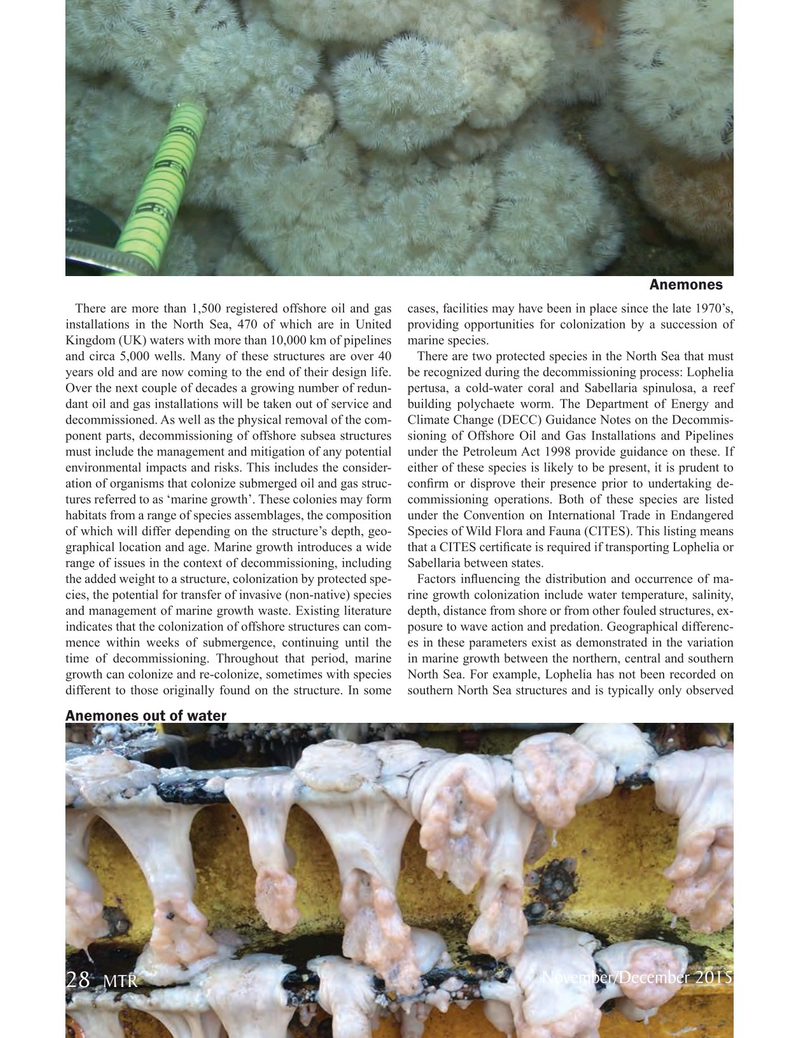
Page 28: of Marine Technology Magazine (November 2015)
Read this page in Pdf, Flash or Html5 edition of November 2015 Marine Technology Magazine
Anemones
There are more than 1,500 registered offshore oil and gas cases, facilities may have been in place since the late 1970’s, installations in the North Sea, 470 of which are in United providing opportunities for colonization by a succession of
Kingdom (UK) waters with more than 10,000 km of pipelines marine species.
and circa 5,000 wells. Many of these structures are over 40 There are two protected species in the North Sea that must years old and are now coming to the end of their design life. be recognized during the decommissioning process: Lophelia
Over the next couple of decades a growing number of redun- pertusa, a cold-water coral and Sabellaria spinulosa, a reef dant oil and gas installations will be taken out of service and building polychaete worm. The Department of Energy and decommissioned. As well as the physical removal of the com- Climate Change (DECC) Guidance Notes on the Decommis- ponent parts, decommissioning of offshore subsea structures sioning of Offshore Oil and Gas Installations and Pipelines must include the management and mitigation of any potential under the Petroleum Act 1998 provide guidance on these. If environmental impacts and risks. This includes the consider- either of these species is likely to be present, it is prudent to ation of organisms that colonize submerged oil and gas struc- con? rm or disprove their presence prior to undertaking de- tures referred to as ‘marine growth’. These colonies may form commissioning operations. Both of these species are listed habitats from a range of species assemblages, the composition under the Convention on International Trade in Endangered of which will differ depending on the structure’s depth, geo- Species of Wild Flora and Fauna (CITES). This listing means graphical location and age. Marine growth introduces a wide that a CITES certi? cate is required if transporting Lophelia or range of issues in the context of decommissioning, including Sabellaria between states.
the added weight to a structure, colonization by protected spe- Factors in? uencing the distribution and occurrence of ma- cies, the potential for transfer of invasive (non-native) species rine growth colonization include water temperature, salinity, and management of marine growth waste. Existing literature depth, distance from shore or from other fouled structures, ex- indicates that the colonization of offshore structures can com- posure to wave action and predation. Geographical differenc- mence within weeks of submergence, continuing until the es in these parameters exist as demonstrated in the variation time of decommissioning. Throughout that period, marine in marine growth between the northern, central and southern growth can colonize and re-colonize, sometimes with species North Sea. For example, Lophelia has not been recorded on different to those originally found on the structure. In some southern North Sea structures and is typically only observed
Anemones out of water
November/December 2015 28
MTR
MTR #9 (18-33).indd 28 12/8/2015 10:33:06 AM

 27
27

 29
29
